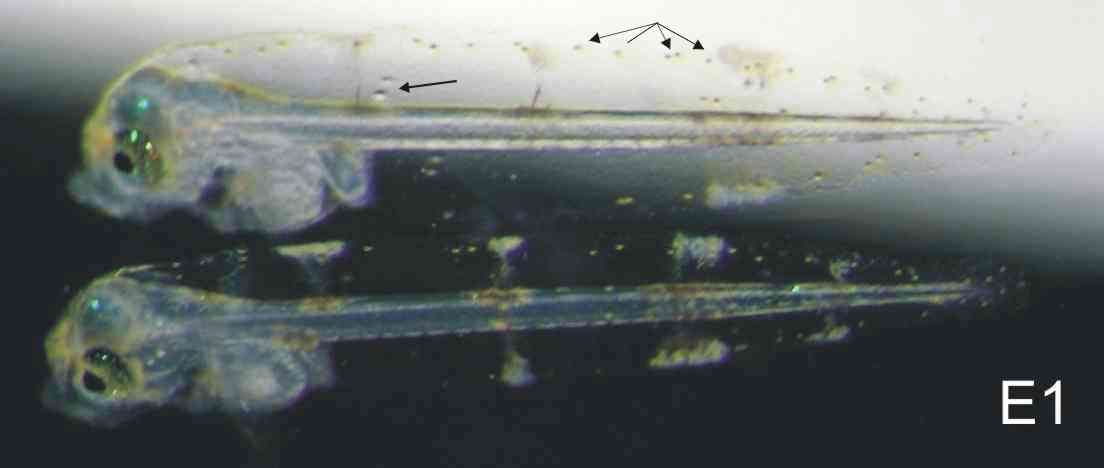Cynoglossidae: M III A8
Cynoglossus or Paraplagusia
Tonguefish







|
Egg diameter in µm |
Number of oil globules |
Diameter of oil globule in µm |
Yolk texture |
Perivitelline space |
Position of oil globule at hatch |
Gut length at eye- pigment stage |
Myomeres |
|
680-700 |
multiple |
NA |
clear |
narrow |
scattered |
31% of NL |
ca 50 |
Egg: The oil globules in this egg may be clustered at the centre of the egg (floating position) or scattered (A). Oil globules are usually light amber, and the embryo becomes covered in yellow pigment spots, with a few scattered on the yolk as well. Black pigment underlies the yellow; best seen on a white background. Incubation is 24-30 hours.
Larva: The 1-day larva is elongate, with a short gut. There are 4 blotches of pale yellow-white pigment from nose to mid-tail, along the notochord, with matching patches on the dorsal and ventral finfold edges, adjacent to the last 3 (D & E). Note the row of tiny raised cones in both the dorsal and ventral finfolds, which are unpigmented (E1, compound arrow), and smaller than the two neuromast cones, one each side of the body (E1, single arrow). By day-4 the yellow pigment has increased, but no elongated dorsal ray is visible (F). (See MIIIA6). C: NH, D: 1 day, E: 3 days, F: 5 days (23°C).
Attempts to rear this egg were unsuccessful, and were not persisted with, as the egg was very similar to Brownells (1979) Cynoglossus capensis, and therefore known to be a cynoglossid. There are, however, more cynoglossid species in KZN waters than in the western Cape, and C. capensis is not known from KZN waters (Heemstra 1986). Seventeen larvae have been sequenced, all indicating the same species, but no match has been found in BOLD, despite clustering with 6 species of Cynoglossus (acaudatus, attenuatus, capensis, zanzibarensis and 2 unidentified species), in my barcode dendrogram (BOLD). The eggs of C. lida are already identified (MIIIA6). Along with FIIA9 and MIIIA4, this egg is a good indicator of inshore water. Barcoding will probably shoiw that this egg belongs to Paraplagusia bilineata, two adult specimens of which are currently being barcoded (November 2014).



| Linked samples | Offshore | Inshore |
| Eggs | 923 | 3789 |
| Hits | 114 | 447 |
Spawns all year round, with a slight summer peak (blue graph), and was the 20th most common egg off Park Rynie (Introductory Notes; Table 3). It was also common in the DHM samples, where it also showed a summer spawning pattern (green graph). The eggs have remained fairly constant in nettings off Park Rynie (white graph). The Park Rynie linked samples had the majority inshore (80%), indicating spawning on or inshore of the 20m depth contour. See Section 7.3 and Table 1 of the Introductory Notes, for more information on the linked samples.